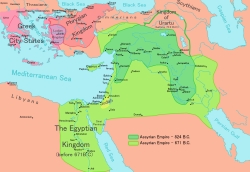NōꞋakh 7th Eve (ËrꞋëv Sha•bâtꞋ)

Law of Societal Degeneration Confirmed
Thus NōꞋakh began a new order: he planted a vineyard, harvested the grapes, fermented a batch of wine to party, got drunk and passed out naked in his tent.
One of his sons, Khâm – with his son, Kᵊna•anꞋ, noticed him but Khâm ignored the situation and did nothing to preserve his father's modesty. When he told his brothers, however, they took a sheet and, backing in so as not to see their father's nakedness, covered him with a sheet.
 |
When NōꞋakh awoke, he realized what Khâm's little boy, Kᵊna•anꞋ, had done to him. For having done nothing to preserve his father's modesty, NōꞋakh cursed both Khâm and his son, Kᵊna•anꞋ, to be slaves of Sheim. In addition to Kᵊna•anꞋ, Africans and Egyptians are descended from Khâm.
Then NōꞋakh blessed ä' for Sheim, saying: 'Blessed is ä', the Ël•oh•imꞋ of Sheim, and the descendants of Yâ•phëtꞋ shall live with the descendants of Sheim.
NōꞋakh lived 29 years after the flood, and died at the age of 79.
Bâ•vëlꞋ – World's First Skyscraper
The descendants of NōꞋakh all spoke the same language as they spread out, repopulating the land of Mesopotamia.
As trade increased, the population of each area increasingly flocked to a nearby city. And trade between cities resulted in a central, hub, city: Bâ•vëlꞋ
In the fervor to construct more durable buildings in Bâ•vëlꞋ, someone discovered that the mud-brick walls containing the kitchen camp-fires were far stronger than new mud-brick walls they were building. So, builders learned to fire mud bricks to make them more durable – like stone. This increased brick strength enabled the builders in Bâ•vëlꞋ to construct bigger and taller buildings.
 300x225.jpg) |
So, the city council decided to build a skyscraper to exhibit their ability to the world. "Let's build a city with a building that reaches into the heavens, that scrapes the sky; telling the world how successful we are and make our people proud to live here and pay their taxes." And they built the world's first skyscraper – the ziggurat. Back then, this was the world's tallest building, standing about 10 stories tall.
At first, this attracted foreign investors and builders to finance and build the ziggurat. But the more foreigners who came, the more complicated it became for everyone to communicate in their different languages. Translators became overwhelmed. It became increasingly difficult for municipal authorities to communicate with the builders, for bosses to communicate with workers; brick-makers couldn't communicate with those who supplied straw or drove the ox-carts, those who supplied water and lunches for all of the various kinds of workers couldn't communicate with workers who were hungry or thirsty to determine how much was needed, where it was needed and when. Everything turned into a bâ•lâ•gōnꞋ; a babble of unintelligible languages. That's why the city became known as Bâ•vëlꞋ.
The different languages multiplying in Bâ•vëlꞋ divided the city into discordant, often clashing, neighborhoods. As a result, inhabitants of the city began to leave, returning to their native lands across the ancient world.
The Birth of AvᵊrâmꞋ
 |
Heads of the various clans in Bâ•vëlꞋ are credited with having scattered across the ancient world to become patriarchs of the ancient 70 nations.
Among the 8th generation of descendants of Sheim Bën-NōꞋakh was a Sheim-ite named TërꞋakh, the father of AvᵊrâmꞋ – who would later change his name to Av•râ•hâmꞋ. AvᵊrâmꞋ was the oldest of three brothers, and the family lived in Ur, southern Mesopotamia.
AvᵊrâmꞋ's youngest brother died leaving behind a son named Lōt and a daughter named Sâr•aiꞋ – whom AvᵊrâmꞋ married.
TërꞋakh intended to move to Kᵊna•anꞋ, but they only got as far as Khâ•rânꞋ, where TërꞋakh decided to settle instead. So the family lived in Khâ•rânꞋ until TërꞋakh died.
Yᵊsha•yahꞋu ha-Nâ•viꞋ noted that, sometime in the distant future, the deterioration of Tor•âhꞋ practice among am Yi•sᵊr•â•eilꞋ would be reminiscent of the period before the Ma•bulꞋ of NōꞋakh. Nevertheless, just as ä' forswore ever bringing about another Ma•bulꞋ, He also forswore ever going ballistic or reprimanding Yi•sᵊr•â•eilꞋ.

Optional parental preparation:
- Review where Mesopotamia was in modern central Iraq.
- How is a mud brick made?
- How tall was the world's first skyscraper?
- What did AvᵊrâmꞋ change his name to?
- Who did AvᵊrâmꞋ marry?
Questions you might anticipate that your child might raise and be prepared to discuss:
- What does "urbanize" mean?
- What is a skyscraper?
- What is a "hub" city?
- What is a patriarch?
- How was Lōt related to AvᵊrâmꞋ?
- How was Lōt related to Sâr•aiꞋ?
Google+ registered author & publisher

